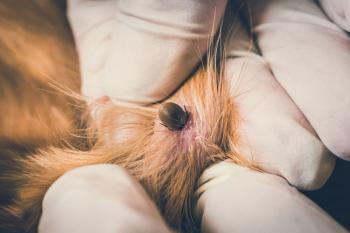
- dvm360 December 2022
- Volume 53
- Issue 12
- Pages: 50
Veterinary infectious diseases in 2023: Will the surge continue?
Here is a look at what disease spikes could be on the horizon for veterinary and human medicine
The past several years have encouraged all of us to expect the unexpected when it comes to infectious diseases. After all, how many once-in-a-lifetime pandemics can we fit into a single lifetime?
For veterinarians, this is all just another day at the clinic, barn, or field. On a disease evolutionary scale, humans have endured COVID-19 quickly followed by monkeypox and Sudan ebolavirus with surges of seasonal influenza and respiratory syncytial virus (RSV) added as the icing on the cake for 2022.
Speaking of surges, just as we are seeing massive outbreaks of seasonal respiratory viruses in humans, we are seeing the same in dogs relative to outbreaks of canine infectious respiratory disease complex (CIRDC).1
As life returns to some version of normal post COVID-19, not only are people back to infecting each another with more traditional respiratory disease, but so are our pets. This is especially true for those spending more time at places such as doggie daycares and dog parks, and less time quarantining with their owners at home.
Veterinary medicine has had to weather those storms and deal with our own unique outbreaks on top of it all. We have seen massive outbreaks of avian influenza virus, with millions of wild and domestic birds infected over the past several years, including the 2022 H5N1 outbreak that defied customary expectations for a seasonal decline through the summer and continues to wreak havoc on the poultry industry and wild birds alike. African swine fever has continued its westward march in Europe because feral pigs do not obey international borders, and it also made its way to the Dominican Republic in 2021, with transmission still occurring.2,3
Companion species also have been affected, with the emergence/identification of new viral and bacterial pathogens as well as spillovers from COVID-19 and monkeypox.4,5
Although it would be comforting to think 2023 is going to finally provide us all with the break we need, it seems like it may be the year it gets worse before it gets better. The translocation of millions of Floridians, whose lives, homes, and pets were tragically impacted by Hurricane Ian, has the potential to be a superspreader event. Only time will tell if we see mass migration of endemic animal diseases from Florida, both regionally and nationally, as was seen after Hurricane Katrina in 2005.6
Even if mass disease migration is not seen, case reports of leptospirosis in people and animals that navigated the floodwaters are likely to rise.7 Those cases will be distributed locally and regionally depending on what infrastructure remains operational and how quickly those affected are able to return home.
We should expect cases of Pythium insidiosum to rise in humans and pets, especially those that became trapped in floodwaters before relocating, and/or encountered standing water during cleanup operations.
Even as the floodwaters become a memory, cases of mosquito-borne disease are likely to remain elevated, in some cases for years to come. Heartworm disease will likely remain elevated for some time, especially with animals that may have been lost during the storm and subsequently turned up in shelters after living outdoors.8 Eastern equine encephalitis virus and West Nile virus cases in equids will likely multiply in many of these areas on top of the ongoing cases in humans and animals that have been seen up and down the Eastern seaboard and into the Midwest.9
Foodborne zoonotic disease outbreaks will also continue to be problematic for pets and pet owners. This bears mentioning not only due to the number of owners feeding raw or homemade diets, but also due to the potential for a substantial economic downturn in 2023 combined with surging inflation increasing the price of commercial diets beyond the budgets of many pet owners. Salmonella, Escherichia coli, Campylobacter, and Listeria will continue to elevate pet and owner infection risk levels, especially in those feeding raw diets.
While the forecast for 2023 seems ominous, or more of the same for so many of us, optimism should be the order of the day. Never have we had so many pet owners, farmers, and other animal caretakers understand the basics of diagnostic testing.
At this point many had polymerase chain reaction and lateral flow tests, with most getting a crash course in respiratory disease transmission. This makes it the golden age of diagnostics and epidemiology as we have a public accustomed to testing and receiving diagnostic information, and an ever-expanding array of options to provide that information across the spectrum of veterinary medicine.
Jarod Hanson, DVM, PhD, DACVPM, DABT, is a veterinary virologist, toxicologist, public health consultant, adjunct faculty member at University of Maryland, and the chief content officer for ProMED. Hanson earned his DVM from the University of Minnesota and his PhD in infectious diseases from the University of Georgia.
References
- Rose L. This is like nothing we’ve ever seen’: respiratory illness in dogs causing problems. WBTV. October 27, 2022. Accessed November 14, 2022. https://www.wbtv.com/2022/10/27/this-is-like-nothing-weve-ever-seen-up- per-respiratory-illness-dogs-causing-problems-charlotte/
- USDA confirms ASF in Dominican Republic. Pig333.com. December 1, 2021. Accessed November 14, 2022. https://www.pig333.com/latest_swine_news/ usda-confirms-asf-in-dominican-republic_17662/2022
- Dominican Republic reports 20 new ASF cases in August. The Pig Site. September 14, 2022. Accessed December 5, 2022. https://www.thepigsite. com/news/2022/09/dominican-republic-reports-20-new-asf-cases-in-august
- Murphy HL, Ly H. Understanding the prevalence of SARS-CoV-2 (COVID- 19) exposure in companion, captive, wild, and farmed animals. Virulence. 2021;12(1):2777-2786. doi:10.1080/21505594.2021.1996519
- Ries J. Monkeypox detected in dog: what we know. Healthline Media. August 16, 2022. Accessed November 14, 2022. https://www.healthline.com/ health-news/monkeypox-detected-in-dog-what-to-know
- Levy JK, Lappin MR, Glaser AL, Birkenheuer AJ, Anderson TC, Edinboro CH. Prevalence of infectious diseases in cats and dogs rescued following Hurricane Katrina. J Am Vet Med Assoc. 2011;238(3):311-317. doi:10.2460/ javma.238.3.311
- Hurricanes, floods and leptospirosis. CDC. October 4, 2022. Accessed November 14, 2022. https://www.cdc.gov/leptospirosis/exposure/hurri- canes-leptospirosis.html
- Katrina’s pet refugees: the heartbreak of heartworm. heartwormsociety.org. March 8, 2006. Accessed November 14, 2022. https://www.heartwormsociety.org/in-the-news/97-katrina-s-pet-refugees-the-heartbreak-of-heartworm
- Eastern equine encephalitis - North America (06): USA (multiple states) horse, donkey. ProMED-mail post. October 21, 2022. Accessed November 14, 2022. https://promedmail.org/promed-post/?id=20221021.8706302
Articles in this issue
almost 3 years ago
Are paid ads worth it?about 3 years ago
Top dvm360 podcasts of 2022: #1about 3 years ago
Top dvm360 articles of 2022: #1about 3 years ago
Top dvm360 podcasts of 2022: #2about 3 years ago
Top dvm360 articles of 2022: #2about 3 years ago
Top dvm360 podcasts of 2022: #3about 3 years ago
Top dvm360 articles of 2022: #3about 3 years ago
Top dvm360 podcasts of 2022: #4about 3 years ago
Top dvm360 articles of 2022: #4Newsletter
From exam room tips to practice management insights, get trusted veterinary news delivered straight to your inbox—subscribe to dvm360.




